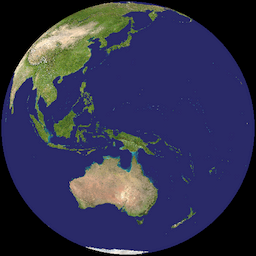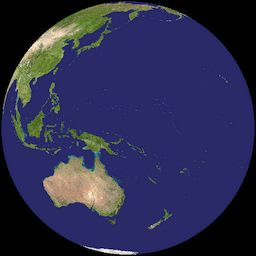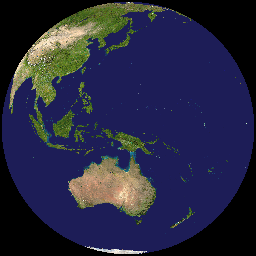



| ||||||||
| ||||||||
|
The geostationary meteorological satellites of Japan have been nicknamed as "Himawari" but we also have a period when the name was not "Himawari." This page summarizes information about recent geostationary meteorological satellites. For your information, satellite images are accessible at Digital Typhoon and Images and Movies of Himawari-8 / Himawari-9 - Next Generation Weather Satellite.
Those meteorological satellites are located in different positions and equipped with sensors with different characteristics as shown below. We also provide related information in the page of Typhoon 200303, which was happened to be active at the time of the switchover.
| Himawari-5 (GMS-5) | GOES-9 | Himawari-6 (MTSAT-1R) / Himawari-7 (MTSAT-2) | Himawari-8 / Himawari-9 | |
|---|---|---|---|---|
| Visible (VIS) | 0.55-0.90 μm @ (1.25km / 6bits) | 0.55-0.75 μm @ (1km / 10bits) | 0.55-0.90 μm @ (1km / 10bits) | 0.64 μm @ (0.5km / 11bits) |
| Infrared 1 (IR1) | 10.5-11.5 μm @ (5km / 8bits) | 10.2-11.2 μm @ (4km / 10bits) | 10.3-11.3 μm @ (4km / 10bits) | 10.4 μm @ (2km / 12bits) |
| Infrared 2 (IR2) | 11.5-12.5 μm @ (5km / 8bits) | 11.5-12.5 μm @ (4km / 10bits) | 11.5-12.5 μm @ (4km / 10bits) | 12.4 μm @ (2km / 12bits) |
| Infrared 3 (IR3) | 6.5-7.0 μm @ (5km / 8bits) | 6.50-7.00 μm @ (8km / 10bits) | 6.5-7.0 μm @ (4km / 10bits) | 6.2 μm @ (2km / 11bits) |
| Infrared 4 (IR4) | Not Available | 3.80-4.00 μm @ (4km / 10bits) | 3.5-4.0 μm @ (4km / 10bits) | 3.9 μm @ (2km / 14bits) |
| Frequency | 1 hour | 1 hour | 1 hour (two observations in one hour for the northern and the southern hemisphere) | 10 minutes |
| Position (Equator / 35,800km above) | 140 E | 155 E | 140 E (MTSAT-2 in standby at 145 E) | 140.7 E |
| Coverage |  |
 |
 |
 |
According to the OSCAR (Observing Systems Capability Analysis and Review Tool) from WMO, the generation of geostationary meterological satellites can be divided as follows.
| Generation | Satellite | Lifetime |
|---|---|---|
| 1st generation (Himawari) | Himawari-1 (GMS-1) | 1977-1989 |
| Himawari-2 (GMS-2) | 1981-1987 | |
| Himawari-3 (GMS-3) | 1984-1995 | |
| Himawari-4 (GMS-4) | 1989-2000 | |
| Himawari-5 (GMS-5) | 1995-2003 | |
| 2nd generation (GOES) | GOES-9 (GMS backup) | 2003-2006 |
| 2nd generation (Himawari) | Himawari-6 (MTSAT-1R) | 2005-2015 |
| Himawari-7 (MTSAT-2) | 2006-2016 | |
| 3rd generation (Himawari) | Himawari-8 | 2014-2030 |
| Himawari-9 | 2016-2030 |
The standard data format has been changed for each generation.
The successor of Himawari, MTSAT-1R, was launched successfully on February 26, 2005. The real-time report and other technical information was provided at MTSAT-1R / H-IIA F7 Countdown. Also I reported the launch from the site on the weblog Keeping Track of MTSAT! (in Japanese). The following briefly summarizes the chronology of the launch of MTSAT-1R, although most links (simply written as "Link") are written in Japanese.
On June 28, 2005, the geostationary meteorolgical satellite of Japan is switched over to Himawari-6 (MTSAT-1R). The satellite has been GOES-9 since May 22, 2003, but the satellite now returned to the series of "Himawari" satellites. Other latest information about Himawari-6 is also updated at Keeping Track of MTSAT! (in Japanese).
| 1999-11-15 | Failure of the launch of MTSAT-1 (Successor of Himawari) by the H-II rocket | Link1 :: Link2 |
|---|---|---|
| 2001-11-15 | The postponement of the launch of MTSAT-1R from the beginning of 2003 to the summer of 2003 due to the delay of a procedure to obtain the export permit | Link1 |
| 2002-05-10 | Decision was made for renting American meteorological satellite GOES-9 due to the delay of he launch of MTSAT-1R | Link1 |
| 2002-12-19 | The beginning of movement of American meteorological satellite GOES-9 for switching over the observation from Himawari satellite | Link1 |
| 2003-04-22 | The re-postponement of the launch of MTSAT-1R due to the trouble of infrared sensors | Link1 :: Link2 |
| 2003-05-22 | The switchover from GMS-5 (Himawari-5) to GOES-9 | From Himawari-5 to GOES-9 |
| 2003-07-15 | The bankruptcy of Space Systems Loral, the company in charge of the production of MTSAT-1R | LORAL REACHES AGREEMENT TO SELL SIX SATELLITES TO INTELSAT FOR UP TO $1.1 BILLION; FILES VOLUNTARY CHAPTER 11 PETITION AS PRECONDITION TO TRANSACTION |
| 2003-08-07 | Space Systems Loral claiming 30 million dollars for additional cost | |
| 2003-10-12 | The rejection of temporary restraining order asking for the continuation of the MTSAT-1R production process | Link1 :: Link2 :: Link3 :: Link4 |
| 2003-11-29 | The failure of the launch of a H2A rocket, planned to be used for the launch of MTSAT-1R | Satellite image of the day :: Link1 :: Link2 :: Link3 :: Link4 :: Link5 |
| 2004-01-30 | Agreement on the delivery of MTSAT-1R in March 2004 | Link1 :: Link2 |
| 2004-03-12 | Carrying-in of MTSAT-1R into Tanegashima | Link1 |
| 2004-12-08 | The decision of the Launch of MTSAT-1R | Link1 :: Link2 |
| 2005-01-19 | The launch of MTSAT-1R decided on February 24 | Link1 :: Link2 |
| 2005-02-26 | The success of the launch of MTSAT-1R by the H-IIA F7 Rocket | Link1 :: Link2 :: Link3 :: Keeping Track of MTSAT! |
| 2005-03-08 | The reach of MTSAT-1R to the geostationary trajectory and the decision of its nickname to "Himawari-6" | Link2 :: Keeping Track of MTSAT! |
| 2005-03-24 | The release of first observation images by Himawari-6 | Link1 :: Link2 :: First impression |
| 2005-06-22 | MTSAT-1R to be in operation from 03UTC on 28 June 2005 | News Release |
| 2005-06-28 | Himawari-6 (MTSAT-1R) started its operation at 0300 UTC | News Release :: Digital Typhoon: Notice: About Himawari-6 Satellite and the Period of Transition |
| 2005-07-14 | The termination of GOES-9 data distribution | Thank you, GOES! (in Japanese) |
| 2005-07-21 | The termination of Himawari-5's operation | Farewell to Himawari-5 (in Japanese) |
| 2006-02-18 | The success of the launch of MTSAT-2 by the H-IIA F9 Rocket | Link1 :: Launch Result of the Multi-functional Transport Satellite 2 (MTSAT-2) by the H-IIA Launch Vehicle No.9 (H-IIA F9) :: Keeping Track of MTSAT! |
| 2006-02-24 | MTSAT-2 is nicknamed as "Himawari-7" | News Release (in Japanese) |
| 2006-05-11 | First images from MTSAT-2 (Himawari-7) | First images from MTSAT-2 :: First images from MTSAT-2 :: Keeping Track of MTSAT! |
Japan Meteorological Agency. Available in Japanese.
http://www.data.kishou.go.jp/satellite/sitemap.html
Japan Meteorological Agency. Information on MTSAT series that are now being used as "Himawari" meteorological satellites.
http://www.jma.go.jp/jma/jma-eng/satellite/
Popular meteorological satellite in Japan for weather forecast. An introductory page from NASDA.
http://www.nasda.go.jp/sat/gms/index_e.html
Meteorological Satellite Center (JMA). Information about GMS satellite.
http://mscweb.kishou.go.jp/
World Meteorological Organization (WMO). Operational meteorological satellites in the world.
http://www.wmo.int/pages/prog/sat/globalplanning_en.php
Images, Data Books and FAQ about GOES Project.
http://rsd.gsfc.nasa.gov/goes/
The History of GOES Project.
http://www.earth.nasa.gov/history/goes/goes.html
National Oceanic and Atmospheric Administration. A brief summary of meteorological / weather satellites (geostationary and polar-orbiting) in the United States.
http://noaasis.noaa.gov/NOAASIS/ml/genlsatl.html
Asahi Shimbun. Available in Japanese.
http://www.asahi.com/edu/newsland/1003a.html
Mainichi Shimbun. Available in Japanese.
http://weather.mainichi.co.jp/news/200305/31-02.html
Available in Japanese.
http://portal.nifty.com/special05/11/12/
The collection of press releases from NASDA about the failure of launch of MTSAT.
http://www.nasda.go.jp/press/category/back-h2f8_e.html
JAXA's main site about the H-IIA rocket.
http://www.jaxa.jp/missions/projects/rockets/h2a/index_e.html
Available in Japanese.
http://biztech.nikkeibp.co.jp/wcs/leaf/CID/onair/biztech/mech/243396
Available in Japanese.
http://nikkeibp.jp/wcs/leaf/CID/onair/jp/biz/312344
Available in Japanese.
http://nikkeibp.jp/wcs/leaf/CID/onair/jp/flash/361778
Opinions on technical problems of MTSAT.
http://www.geocities.com/jspacetrue/
|